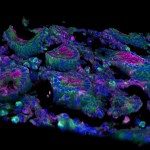Link to Pubmed [PMID] – 16777597
Cell 2006 Jun; 125(6): 1055-67
High-level immune activation and T cell apoptosis represent a hallmark of HIV-1 infection that is absent from nonpathogenic SIV infections in natural primate hosts. The mechanisms causing these varying levels of immune activation are not understood. Here, we report that nef alleles from the great majority of primate lentiviruses, including HIV-2, downmodulate TCR-CD3 from infected T cells, thereby blocking their responsiveness to activation. In contrast, nef alleles from HIV-1 and a subset of closely related SIVs fail to downregulate TCR-CD3 and to inhibit cell death. Thus, Nef-mediated suppression of T cell activation is a fundamental property of primate lentiviruses that likely evolved to maintain viral persistence in the context of an intact host immune system. This function was lost during viral evolution in a lineage that gave rise to HIV-1 and may have predisposed the simian precursor of HIV-1 for greater pathogenicity in humans.

